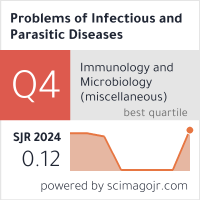A RETROSPECTIVE STUDY ON THE DISTRIBUTION OF E. COLI ENTERITIS IN BULGARIA FOR A PERIOD OF TEN YEARS (2011-2020)
DOI:
https://doi.org/10.58395/pipd.v50i1.84Keywords:
diarrhea, E. coli , ETEC, EPEC, EIECAbstract
BACKGROUND. Intestinal diseases caused by diarrheagenic E. coli account for a significant proportion of infections, especially in children. E. coli enteritis can occur as sporadic cases but often assumes an epidemic nature. This study aims to determine the significance and prevalence of infections caused by diarrheagenic E. coli in Bulgaria for a period of ten years 2011-2020. MATERIALS AND METHODS. The etiological role and distribution of diarrheagenic E. coli among Bulgarian population for the last decade were determined by a retrospective analysis of microbiological and epidemiological data. RESULTS. Data from the studied period reveal the role of enterotoxigenic E. coli (ETEC) O6 as a leading etiological cause of epidemic and sporadic enteritis in the country, followed by enteropathogenic E. coli (EPEC) O126 and O127. There are only two reported cases of lethal hemorrhagic uremic syndrome (HUS) caused by enterohemorrhagic E. coli (EHEC) that happened in 2011. Most affected by diarrheagenic E. coli (DEC) infections are infants and young children. Neonatal meningitis in Bulgaria is rare, the etiological agents are E. coli O18 and O25. The most common registered DEC infections are during the summer months of May - September. Several epidemics have been registered in young children, and the etiological cause is ETEC O6. CONCLUSION. The main etiological agent of E. coli infections in Bulgaria is ETEC O6, and infants and young children are at risk. Recent DEC epidemics have not been reported. The ethiologic diagnosis of infections is underestimated, which is a risk factor for increasing the number of healthy carriers, outbreaks and unlimited agent spreading through the food chain.
Downloads
References
James P. Nataro and James B. Kaper. Diarrheagenic Escherichia coli. Clin. Microbiol. Rev. 1998. Vol.11, №1, p 142-201.
Fallah N., Ghaemi M., Ghazvini K., Rad M. & Jamshidi A., Occurrence, pathotypes, and antimicrobial resistance profiles of diarrheagenic Escherichia coli strains in animal source food products from public markets in Mashhad, Iran, Food Control (2020), doi.org/10.1016/j.foodcont.2020.107640.
Pushker Raj. Pathogenesis and Laboratory Diagnosis of Escherichia coli-associated Enteritis. CMNEE. 1993. Vol15(12), p 89-96.
Samer A Al‑Hilali, Ali M Almohana. Occurrence and molecular characterization of enteropathogenic Escherichia coli serotypes isolated from children with diarrhoea in Najaf, Iraq. Indian Journal of Medical Microbiology, (2011) 29(4): 383-8. DOI:10.4103/0255-0857.90171
Magdalena T. Nuesch-Inderbinen, Eveline Hofer, Herbert Hachler, Lothar Beutin and Roger Stephan. Characteristics of enteroaggregative Escherichia coli isolated from healthy carriers and patients with diarrhoea. Journal of Medical Microbiology (2013), 62, 1828–1834 DOI 10.1099/jmm.0.065177-0.
Julio A. Guerra, Chengxian Zhang, Jonathan E. Bard, Donald Yergeau, Natasha Halasa and Oscar G. Gómez-Duarte. Comparative genomic analysis of a Shiga toxin-producing Escherichia coli (STEC) O145:H25 associated with a severe pediatric case of hemolytic uremic syndrome in Davidson County, Tennessee, US. Guerra et al. BMC Genomics (2020) 21:564
Shih‑Chun Yang, Chih‑Hung Lin, Ibrahim A. Aljuffali, Jia‑You Fang. Current pathogenic Escherichia coli foodborne outbreak cases and therapy development. Arch Microbiol (2017) 199:811–825. DOI 10.1007/s00203-017-1393-y.
Servin AL. Pathogenesis of human diffusely adhering Escherichia coli expressing Afa/Dr adhesins (Afa/Dr DAEC): current insights and future challenges. Clin Microbiol Rev. 2014 Oct;27(4):823-69. DOI: 10.1128/CMR.00036-14. PMID: 25278576; PMCID: PMC4187631.
Javadi K, Mohebi S, Motamedifar M, Hadi N. Characterization and antibiotic resistance pattern of diffusely adherent Escherichia coli (DAEC), isolated from paediatric diarrhoea in Shiraz, southern Iran. New Microbes New Infect. 2020 Oct 10;38:100780. DOI: 10.1016/j.nmni.2020.100780. PMID: 33163200; PMCID: PMC7607503.
Centers for Disease Control and Prevention, National Center for Emerging and Zoonotic Infectious Diseases (NCEZID), Division of Foodborne, Waterborne, and Environmental Diseases (DFWED). Page last reviewed: May 3, 2019.
David M. Gordon. The ecology of Escherichia coli. Chapter 1 in Escherichia coli Pathotypes and Principles of Pathogenesis. Second Edition. 2013. Elsevier Inc. ISBN: 978-0-12-397048-0
Black, R.E., 1990. Epidemiology of travelers’ diarrhea and relative importance of various pathogens. Rev. Infect. Dis. 12 (Suppl. 1), S73–79.
Robert Steffen, MD, Epidemiology of travellers’ diarrhea, Journal of Travel Medicine, Volume 24, Issue suppl_1, April 2017, Pages S2–S5,
Subekti, D.S., Lesmana, M., Tjaniadi, P., et al., 2003. Prevalence of enterotoxigenic Escherichia coli (ETEC) in hospitalized acute diarrhea patients in Denpasar, Bali, Indonesia. Diagn. Microbiol. Infect. Dis. 47 (2), 399–405.
von Mentzer, A., Connor, T., Wieler, L. et al. Identification of enterotoxigenic Escherichia coli (ETEC) clades with long-term global distribution. Nat Genet 46, 1321–1326 (2014).
Outbreak of Shiga toxin-producing E. coli (STEC) in Germany 27 May 2011. European Centre for Disease Prevention and Control, 2011. https://www.ecdc.europa.eu/sites/default/files/media/en/publications/Publications/1105_Risk_Assessment_Ecoli.pdf. Last accessed Feb. 21.2022.
Xu A, Johnson JR, Sheen S, SommersC. 2018. Draft genome sequences of fiveneonatal meningitis-causing Escherichia coliisolates (SP-4, SP-5, SP-13, SP-46, and SP-65).Genome Announc 6:e00091-18.
Ste´phane Bonacorsi, Edouard Bingen. Molecular epidemiology of Escherichia coli causing neonatal meningitis. IJMM. 2005. Vol. 295, 373–381. doi:10.1016/j.ijmm.2005.07.011.
Yanli Liu Minli Zhu Xiaoqin Fu Jiaojiao Cai Shangqin Chen Yuanyuan Lin Na Jiang Si Chen Zhenlang Lin. Escherichia coli Causing Neonatal Meningitis During 2001–2020: A Study in Eastern China. International Journal of General Medicine 2021:14 3007–3016.
ECDC- https://www.ecdc.europa.eu/en/escherichia-coli-ecoli/surveillance/atlas. Last accessed Feb. 21.2022.
Downloads
Published
Issue
Section
License
Copyright (c) 2022 Maria Pavlova, Ekaterina Alexandrova, Galin Kamenov, Metodi Popov (Author)

This work is licensed under a Creative Commons Attribution 4.0 International License.






